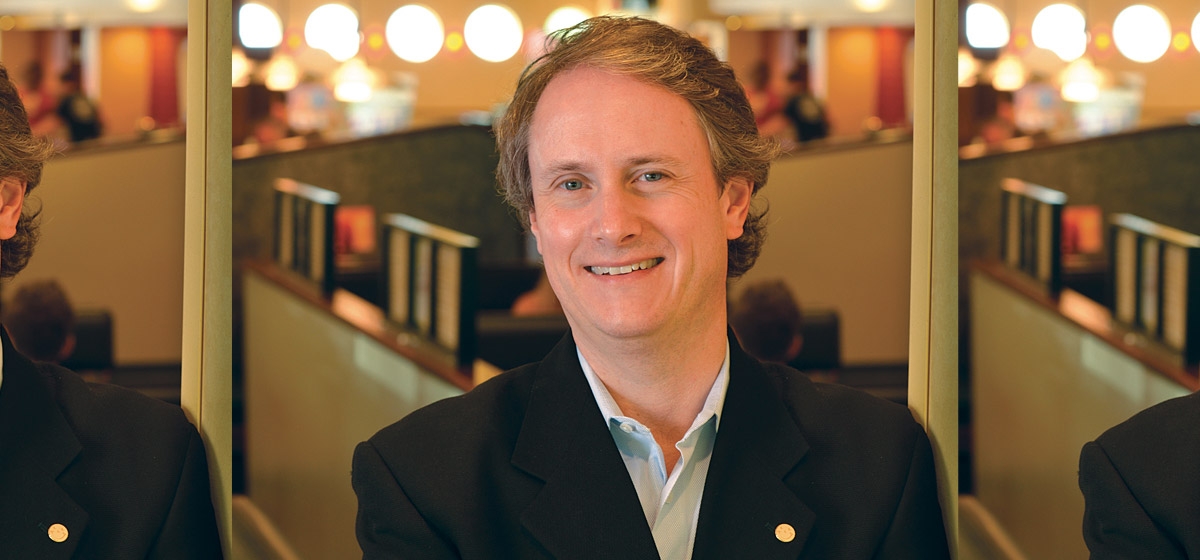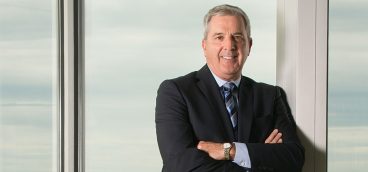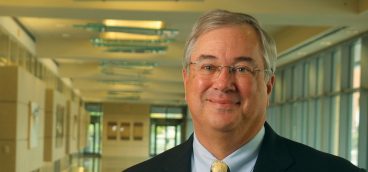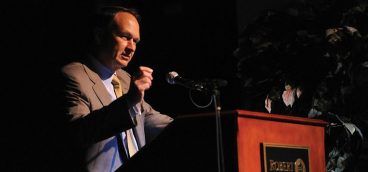
Eat’n Park started out back in 1949 as a very small restaurant on Saw Mill Run Boulevard. Larry Hatch started it, and believe it or not, on the first day, he opened at breakfast and closed before dinner because he was too busy. He couldn’t keep up. Those of us in the restaurant business wish that were the case now, but he ultimately closed at six o’clock, regrouped, set back up and opened up the next morning. And that was the start of Eat’n Park as we know it.
Hatch was a businessman, and he realized early on that he could not trademark the name Park’n Eat. It was a sort of natural term. There was a restaurant in California trying to trademark it, but they were unsuccessful. He said, “if I can’t trademark Park’n Eat, I’ll just flip with Eat’n Park, and there’s how the name came about. From 1949 until 1996, this is what we were about: Eat’n Park restaurants. It was one concept, and in 1996, we probably had about 75 restaurants.
Up until then, innovation was all around keeping this brand alive. Remember Howard Johnson’s—Ho Jo’s—and Sambo’s? I could go on and on about restaurant concepts that aren’t around anymore.
My father was a banker with what was then Pittsburgh National Bank and came over as Eat’n Park’s treasurer in the 1970s. He ultimately bought the company in the early ’80s. At that point, my father was all about innovating on the restaurant concept. Things like the smiley cookie and the bakery. It doesn’t sound like a big deal now, but there were no full-service bakeries in restaurants back in the ’70s and ’80s. And we created our salad bar, where now 25 percent of our guests eat. Those are things that kept us alive.
1995 was a key year (I wasn’t at the company yet). My brother, Brooks, had just come back to the company. At that point, my father decided he did not want to take the company national, but wanted to stay regional. That’s how we got into many of the additional concepts we currently have. So now we are in eight states, with 9,500 team members and over 175 different locations. And we serve over 50 million people.
Eat’n Park restaurants now make up only 40 percent of the company. From ’96 to 2015, we’ve evolved dramatically. But the culture has stayed the same. It starts with taking care of the people. When I say the people, ultimately that is our team members. Treating all 9,500 people as family. Mother’s Day was our busiest day of the year, and many of us in the corporate support center spent our Mother’s Day on the road and in our restaurants.
It’s the greatest day of the year, and I love going out there. People are happy, friendly, and we’re all celebrating mothers. I was over at a New Kensington restaurant that morning, and we’ve got an 85-year-old server who’s worked every Mother’s Day since she started with us 35 years ago. She comes in and hands out smiley cookies to all the moms. It’s treating the guests just like family.
In growing a business like ours, we truly believe diversification is a real plus.
Now we’ve got seven or eight different brands, and every year we sit down and determine where to put our capital and investment—being a privately held company, there’s only so much capital to go around. Where do we spend that capital? We typically look for a 25 percent return on capital, so we look at the brands that have the opportunity to exceed that and invest the majority of the money there.
We’re constantly trying to figure out what we need to keep our brands unique—from Parkhurst Dining to Cura, which provides dining to senior and medical facilities, to Eat’n Park. And at the same time, we’re trying to bring some of the best practices across the different brands. We’re working to keep everyone informed now that we’ve grown beyond just Eat’n Park. We have lots of different executives working in different brands, and they always want to know about everything that’s going on.
One thing I struggle with is, when we’ve got seven or eight different brands, how do we allocate our time? Which brands do you spend the most amount of time on? Dan Wilson, our CFO, and I talk about this a lot. Eat’n Park is obviously our legacy brand. It’s probably in the most challenging of all markets. It never stops amazing us how we have new competitors come in just about every day, and these competitors come in with brand new buildings. Our buildings are not the nicest looking buildings, I’ll admit. Some are nice, and we’re continuing to reinvest about $5 million to $6 million every year in our Eat’n Park brand. But our buildings will never be as nice as some of these brand new competitors. So how do we continue to keep our core fresh?
People and innovation
It really starts with our core values, which have been in place since 1996. There are five of them, but I really want to single out two—people and innovation. These are taught on day one in every orientation, whether it’s a management orientation or hourly team members.
With 9,500 team members and over 50 million guests, it’s all about the people. We can’t be in this business without people. Forget the buildings. Forget the food. It’s the service.
Ultimately, when we talk about caring about people, we must value their opinion. It comes down to sitting down with individuals, learning what they care about. What are their opinions, and how can they make our concepts better? We spend a lot of time reaching out to our team members, trying to understand how we can be better.
Turnover is a big issue. In the restaurant business last year, believe it or not, the industry turnover rate was about 85 percent. Ours was just under 50 percent. You may think, “50 percent—that’s still unbelievably high.” Do you know of other businesses with a turnover rate of 50 percent or more? It’s staggering, and it’s getting worse right now, because unemployment is getting very low. But again, people are what it’s all about.
We also care very much about innovation. To stay relevant for 65 years in the restaurant business, you have to innovate and be willing to make a lot of mistakes. Obviously, the bakery, the smiley cookie, brunches and those kinds of things have been big successes. They’ve kept us in business, but there’ve been a lot of other things that haven’t worked, like the Park Classic Diner. Many have come and gone.
Innovation is all about staying relevant. The two things around innovation that we focus on are how can we serve our guests better and how can our units be simpler to operate for our team members? How can we make the job for our 9,500 team members easier, simpler on a daily basis, and more rewarding?
Here are a couple of examples of innovation. Five or six years ago, delivery was key in our business. People were competing against us, and they were delivering to peoples’ homes. We were not going to do that. Take-out was growing—it was 4 or 5 percent of our sales at the time. You’ve been to those restaurants, where you pull up outside and someone comes to your car. They run back in with your payment and bring the food back out. It’s pouring rain, and you’ve gotten soaked twice because your window goes down twice.
We had a few of those, and they just weren’t working. Folks were complaining on rainy days. We went back and spent a year and a half—in peoples’ homes, finding out the way they order food and the way they get food into their homes. And we realized the way we have to do this is just like every other fast food restaurant—put windows into our buildings.
Now we have 43 take-out windows. Our takeout business has gone from 4 percent to 10 percent in just a few years. It really is a game changer, and what’s changed, in addition to sales, is customer satisfaction. We now have about 97 percent order accuracy. But it was realizing that we had gone down the wrong path to begin with and retrenching. We started over, spent a year and a half analyzing it, and now we’re on the right path.
Another example is salad bars. About two years ago, we were doing 20 percent of our business through salad bars. We decided it was time to reinvent it. You can never rest on your laurels—at least in our minds. After a year’s research, we realized people really want fruit, so we added a lot more fruit, and now it’s a soup, salad and fruit bar. Our salad bar sales are now 25 percent, and it’s something that clearly differentiates us from the competition. There just aren’t many salad bars out there anymore, and there’s a good reason. They’re a pain in the rear end to operate. That’s probably why most people got rid of them, but they clearly are something that can differentiate us, and that’s something that we’ll continue to focus on
.
Finally in innovation is remodels. They’re very difficult decisions, because the return on invested capital is not going to hit 25 percent when you’ve got a building that’s got nothing left in it and it’s kicking off a heck of a lot of cash flow. So when you invest $2.5 to 3 million in a new restaurant, the return’s not going to be there, but what will be there is another 30 years in that building. And being a privately held company, we typically take a look at the long horizon, sometimes to a fault, quite frankly. But that’s what it’s all about, and making sure we’re going to survive.
Internally, we talk a lot about needing to fail faster. At every new management orientation, I say, “When you get out there, make mistakes. Make them over and over and over. Try not to make the same mistake over and over, but try to make mistakes. That’s how we learn.”
If we’re not making mistakes, we’re not innovating. We’re not pushing the envelope. We’re not doing things bigger, better, faster. Right now, it’s been a frustrating year on the take-out front, because we were ready to implement online ordering, but we realized we blew it. We started about three years ago saying it’s time for us to finally do this. We were working with a vendor partner, and we were seeing glitches all along the way. We didn’t make a change quick enough. We waited all the way to the end—and then our vendor said they couldn’t do it.
Making a family business work
My brothers and I are second generation. My father retired in 2008. My mother also retired about four years ago. In a family business like ours, our non-family executives are key. Those folks are saints to deal with us, trying to balance the family versus the business and what’s best. Communication in a family business is never ending—trying to fill people in on what’s going on, what’s not going on, and what they need to know about. That’s clearly the No. 1 thing.
We also have to balance our family interest versus the business. We need to make sure we’re supporting our family and the 9,500 lives that come to work every single day at Eat’n Park. That can be a challenge at times, especially when you’re looking way out 10, 20, 30, 40 years—and when many of our team members are looking for a paycheck right now.
And it may sound trivial, but we also have to try to separate holidays from business discussions. We’re getting better at that.
The biggest challenge we and many family companies face is trying to separate the individual jobs we all do within the organization. My brother Brooks oversees the purchasing, and I try to stay out of all purchasing decisions. My brother Mark oversees our corporate dining matters, and I try to stay out of that. We enjoy being together, but those are best practices in a family business.
We’re not publically held, so that’s a big plus. We can do things at our own pace, and in some cases, internally, people think we move too slowly. In some cases we’ll move faster. Delicious Raw, which is a very new juice concept downtown, is an example. A year ago we made an internal announcement that we were finished doing new things. Hello Bistro was growing, and we were getting ready to open our fourth. Parkhurst and Cura were growing. We were reinvesting in the Eat’n Park brand with new buildings. But then my brother Mark and I came up with this great idea—this juice thing—so all of a sudden we were preparing a juice concept. People were like, “I thought we said we weren’t doing anymore new concepts.” Well, we sort of like this one, and that’s what’s fun about family business. If you come across something you really like, you can do it.
We have the opportunity to develop things around the family interests. My brother Mark came back in 2003. He was working for a restaurant chain out east, and he really had a passion around independent restaurants. He came back and developed Six Penn Kitchen downtown. That was sort of his baby. He also has developed The Porch in Schenley Plaza in Oakland. And he’s developed the Hello Bistro concepts.
My mother and father have always been giving back to the community, and we’ve continued that. And we’re seeing opportunities to give back in unique ways via donating chefs’ talents, giving to the food bank or just volunteering in general. And since 2003, we’ve taken on this big campaign with local farmers. Last year, 23 percent of our food for Six Penn Kitchen was purchased locally, which is amazing given that, for most of the winter, we can’t buy anything local. The big competitors can’t do that because it’s just too difficult with their purchasing systems. People want to support companies that are making a difference in the community, so we really play that up, and we think that’s an opportunity to grow.
People always ask, “Will you stay with the business forever?” At this point, I love what I do. I don’t know if everybody will, and we’ve spent a lot of time over the last few years discussing it, especially with the third generation. What’s next for them?
What we don’t want to do is make our generation or the next feel as if they’re handcuffed to the business. If somebody doesn’t want to come into the family business, or if one of us wants to leave, that’s an option. You’re not going to be looked down on. That’s really new in our business and our family. Three or four years ago, we would have thought we would never leave, and the grandkids would absolutely come into the business. But that has sort of changed as we’ve continued to grow. There are opportunities for folks to do different things. We’ll see how that evolves. Of course, there is a little pressure not to screw the thing up, so there is something for the next generation to come into.
Ultimately, we love what we do, and we appreciate everyone’s support from the community. And we’re looking to be around for 65-plus more years, as long as we continue to make the right investments and hire the right non-family business executives. We think the future of the business is bright.





